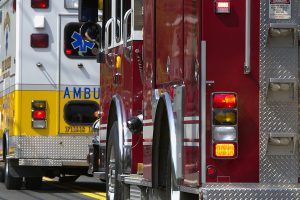 FirstNet is a nationwide wireless broadband network for first responders being built and deployed through a first of its kind public-private partnership. FirstNet was borne out of the September 11, 2001 tragedy where it became clear that the radio systems police, fire, and paramedics relied on did not easily operate across agencies. First responders also could not rely on land and mobile phone lines as they were overwhelmed by a high volume of calls. The 2004 9/11 commission report cited this lack of connectivity as a fundamental problem for first responders and pushed for solutions to be developed quickly to support everyday public safety activities as well as response to catastrophes.
FirstNet is a nationwide wireless broadband network for first responders being built and deployed through a first of its kind public-private partnership. FirstNet was borne out of the September 11, 2001 tragedy where it became clear that the radio systems police, fire, and paramedics relied on did not easily operate across agencies. First responders also could not rely on land and mobile phone lines as they were overwhelmed by a high volume of calls. The 2004 9/11 commission report cited this lack of connectivity as a fundamental problem for first responders and pushed for solutions to be developed quickly to support everyday public safety activities as well as response to catastrophes.
The development of FirstNet began in 2012 when the First Responder Network Authority was established and a law was put in place that allocated 20 megahertz of spectrum and $7 billion to establish a broadband network dedicated to the nation's first responders. FirstNet was launched in 2018.
The development of FirstNet was borne out of crisis, but the functionality of the network provides immense support to the day-to-day functioning of public safety operations. For example, Parma, Ohio -- a Cleveland suburb of 80,000 -- had concerns with limited access and communication shortfalls. They had only one cell tower and difficulties communicating with neighboring police departments and first responders. With their integration into FirstNet, Parma's systems are interoperable with neighboring cities and its first responders can use data transmission in a variety of emergency situations. During this year's pandemic ambulances were able to conduct video conferences with emergency rooms so that equipment could be prepared for critically-ill patients before they arrived.
New features are routinely added to FirstNet with the following improvements announced in January of 2021:
- MegaRange -- High-power user equipment solution that improves uplink data speeds at the edge of the network and provides a more reliable coverage area.
- Z-Axis for FirstNet -- Enables a new level of indoor spatial awareness, giving responders vertical location information so they can locate how high up team members are in a particular building.
- Compact Rapid Deployables -- These "cells on wheels" can be quickly deployed by a single person and link to FirstNet via satellite for emergency operations in remote areas, as well as places where communications may be temporarily unavailable.
- LMR Interoperability for FirstNet Push-to-Talk -- Allows responders with land mobile radios to communicate with users on FirstNet PTT and vice versa.
To keep us with FirstNet and other public safety technologies and policies, check out these events and resources:
- ASPA 2021 Annual Conference (April 9-15, 2021; virtual) -- With the theme, "Picking Up the Pieces: Pandemics, Protests and the Future of Public Service," this American Society for Public Administration event is a global collaboration to share information about 2020's challenges and determine next steps to take.
- AFCEA Bethesda Law Enforcement and Public Safety Technology Forum (May 26, 2021; virtual) -- Government and industry stakeholders share ideas and experiences on how law enforcement and public safety agencies can leverage digital technology to sustain rapid innovation and be better positioned to protect the nation and all of its communities.
- Navigator 2021 (July 13-15, 2021; Las Vegas, NV) -- Held for medical, fire, and police dispatching as well as secondary triage nurses, this event provides keynotes, panel discussions, networking, and certification options.
- 21st Century Fire and Emergency Services (white paper) -- Local governments have begun addressing such issues as climate change, affordable housing, homelessness, immigration, the opioid epidemic, and behavioral health. This reality has led local fire and emergency services to become the health and safety net for communities. This paper outlines several critical issues that are impacting local governments today and others that will have an effect over the course of the next three decades.
- From Reactive to Proactive: Transforming Public Safety with Safe Cities Technologies (white paper) -- As populations rise and threat scenarios increase, cities are finding that the traditional siloed operational models and infrastructure systems are no longer up to the task. Agencies need to communicate and collaborate more efficiently and effectively, and take advantage of the many digital tools now available.
Let us know the resources you are using to stay up to date on public safety technology.
Be sure to check out GovEvents for a complete listing of conferences, virtual events, and webinars and GovWhitePapers for 1000+ white papers, case studies and infographics!



